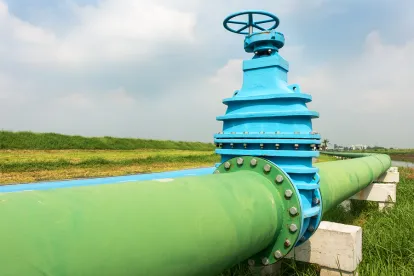On March 22, 2021, the Federal Energy Regulatory Commission issued an order setting forth new standards it will use to evaluate the greenhouse gas (GHG) emissions associated with natural gas pipeline projects. The order, which FERC publicly touts as a compromise approach, may help lay to rest questions about FERC’s treatment of GHGs in environmental analysis and licensing processes, an issue that has proven highly divisive in recent years. The new order makes clear that FERC will now consider the GHG impacts of natural gas pipelines, both as a part of its environmental analysis of pipeline proposals and as one of the factors it will weigh in determining whether a pipeline is in the public interest and therefore should be issued a certificate of public convenience and necessity (CPCN). CPCNs are required to authorize the construction of an interstate pipeline under Section 7 of the Natural Gas Act (NGA).
The decision underscores the importance of FERC’s February 18, 2021, Notice of Inquiry, which seeks comments on several major issues arising in FERC CPCN proceedings. Among the questions posed by FERC is how it should evaluate the impact of GHGs associated with proposed natural gas pipelines. Comments on the Notice of Inquiry are current due on April 26, 2021, although several major interest groups have sought an extension of that deadline.
Key Takeaways
While the order does not explicitly address many questions regarding FERC’s approach to weighing the impacts of GHGs, it does clarify the following:
-
FERC will abandon its prior policy regarding GHGs, where it concluded that it lacks a model to reasonably evaluate the climate impacts of individual projects and that such impacts are too speculative to include its environmental analysis. Instead, FERC will consider a project’s GHG impacts along with its other environmental impacts as part of the “hard look” at environmental impacts required under the National Environmental Policy Act (NEPA).
-
At least as a threshold matter, FERC will look at the project’s GHG emissions as compared to total U.S. emissions.
-
FERC will also examine whether a project is consistent with any state policies limiting GHG emissions.
-
A project’s GHG emissions will be considered, “along with many other factors when determining whether a project is required by the public convenience and necessity,” the test a project must pass to obtain a certificate under NGA Section 7.
-
The environmental conditions imposed on a pipeline will be integral to FERC’s treatment of the GHG emissions issue in environmental analysis.
-
The order also specifically references the February 18 Notice of Inquiry, suggesting that FERC will use that proceeding as the vehicle to formalize and refine its new approach to GHG analysis.
Several questions are not addressed in the order, including:
-
Whether or how FERC will evaluate the “downstream” GHG impacts of a project, i.e., the impacts of GHGs emitted by end-users burning gas that is transported through the pipeline. Nor does it indicate whether or how FERC will evaluate “upstream” GHG impacts, i.e., those related to whether a pipeline permits the production from new natural gas fields and their associated GHG impacts.
-
Whether FERC will incorporate the Biden Administration’s recent Executive Order and related work on the social cost of carbon in its NEPA analysis (currently being challenged in federal district court by several states).
-
How a project would be determined to have significant enough GHGs to trigger the requirement for an Environmental Impact Statement, and whether that would be based on some specific threshold measured by increase of GHGs as a percentage of national GHG emissions.
-
How the cumulative impacts of pipelines on GHG emissions will be evaluated.
Background
The FERC order concerns a relatively modest project, the replacement of roughly 87 miles of aging gas pipelines in South Dakota and Nebraska with new pipeline. Unsurprisingly, the order approves the proposed project. The project is a replacement of an existing pipeline rather than an expansion of pipeline capacity. Its only new impacts are those directly associated with the construction of the project. Because the project does not involve an expansion of pipeline capacity, it will not affect either upstream or downstream GHGs, which have proven to be the most contentious issues for FERC in recent years.
It is perhaps surprising that FERC chose this project to announce its new policy regarding GHG analysis. But, at least in this limited context, the order makes clear that FERC will now consider GHG emissions associated with pipelines along with the other environmental issues it evaluates when considering the environmental impacts of pipeline projects. The order overturns FERC’s prior policy, which concluded that assessing the climate impacts of a particular project is highly speculative and therefore beyond the agency’s obligations to consider under NEPA. This approach has proved controversial, and has twice been questioned by the D.C. Circuit Court of Appeals, which found in Sierra Club v. FERC, 867 F.3d 1357 (2017), and again in Birckhead v. FERC, 925 F.3d 510 (2019), that the downstream GHG emissions from consumption of gas transported via new natural gas pipelines are reasonably foreseeable and therefore generally must be considered as part of the “hard look” at environmental impacts of federal action required under NEPA, or FERC must at least better explain why they cannot be assessed.
The order provides a glimpse into how FERC may evaluate the GHG emissions associated with pipeline proposals. In this case, FERC found that total GHG emissions associated with the project’s construction and ongoing operations (19,655 MT of CO2-equivalent and 351 MT annually) is miniscule compared to the overall level of GHG emissions in the U.S. (a bit less than 6 billion MT annually), hence the project’s GHG emissions do not represent a significant environmental impact triggering the need for a full environmental analysis. The order also compares the project’s emissions to the state-level emissions from South Dakota and Nebraska and similarly concludes that the emissions levels are a tiny fraction of these states’ total emissions. Hence, although many questions remain, FERC will in the future at least examine the total GHG emissions associated with a proposed project and determine whether these are significant in the context of the nation’s overall GHG emissions. Whether FERC’s rationale survives judicial review remains an open question.
Notably, the order was supported by former FERC Chairman Neil Chatterjee, who had been at loggerheads with current Chairman Richard Glick on the GHG analysis issue for much of his tenure. It was also supported by recent Democratic appointee Allison Clements.
But the order provoked a strongly-worded dissent from Commissioner Danly (who briefly chaired the Commission in the waning days of the Trump Administration), who vehemently disagreed with the new policy on a variety of grounds, both procedural and substantive. Commissioner Danly’s dissent also includes what amounts to an industry call to action, in which he urges interested parties to intervene in every pipeline proceeding now open at FERC to push back on the new GHG policy.
Commissioner Christie, the newest Republican appointee, also dissented, but on the much narrower ground that the Commission should have waited for the process initiated by the recent Notice of Inquiry to run its course rather than using this proceeding to announce a new GHG policy in this relatively obscure docket.
Next Steps
FERC’s order represents a sea change regarding its approach to GHG emissions and its obligations under NEPA. Additional changes to FERC’s approach are likely in light of the ongoing Notice of Inquiry process and as the Commission addresses specific issues in future orders, such as upstream and downstream GHG emissions. But the order leaves little doubt that the GHG impacts of pipeline proposals will receive closer scrutiny from the Commission than they have in the past. The order also brings FERC more in line with most recent court decisions and with the recent reinstatement of Obama-era final guidance on GHG analysis in NEPA reviews.
Given the importance of the issue, interested parties should avail themselves of the opportunity to comment in the Notice of Inquiry proceeding (FERC Docket No. PL18-1-000). They may also wish to intervene in one or more of the open proceedings identified in Commissioner Danly’s dissent.






 />i
/>i

